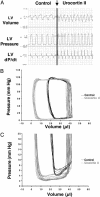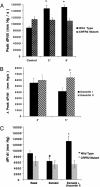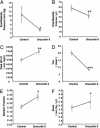The cardiovascular physiologic actions of urocortin II: acute effects in murine heart failure
- PMID: 14990799
- PMCID: PMC373525
- DOI: 10.1073/pnas.0307324101
The cardiovascular physiologic actions of urocortin II: acute effects in murine heart failure
Abstract
Corticotropin-releasing factor (CRF) and its paralogues urocortin (Ucn)I, -II, and -III signal by activating their receptors, CRF receptors (CRFR)1 and -2, to maintain homeostasis through endocrine, autonomic, and behavioral responses. CRFR2 is found in cardiomyocytes and in endothelial and smooth muscle cells of the systemic vasculature. Echocardiography and cardiac catheterization were used in mice to assess the physiologic effects of i.v. UcnII and CRFR2 deficiency on left ventricular function and the systemic vasculature. UcnII treatment augmented heart rate, exhibited potent inotropic and lusitropic actions on the left ventricle, and induced a downward shift of the diastolic pressure-volume relation. UcnII also reduced systemic arterial pressure, associated with a lowering of systemic arterial elastance (end-systolic pressure/stroke volume) and systemic vascular resistance. CRFR2-deficient mice showed no alteration in cardiac contractility or blood pressure in response to UcnII administration, suggesting that the effects of UcnII are specific to CRFR2 function. Pretreatment with a beta-adrenergic receptor antagonist, esmalol, had no effect on the inotropic or lusitropic effects of UcnII in vivo, indicating that its actions are independent of beta-adrenergic receptors. Single i.v. bolus administration of UcnII to a heart failure model (muscle-specific LIM protein-deficient mice) produced significant enhancement of inotropic and lusitropic effects on left ventricular function and improved cardiac output. These results demonstrate the potent cardiovascular physiologic actions of UcnII in both wild-type and cardiomyopathic mice and support a potential beneficial use of this peptide in therapy of congestive heart failure.
Figures





References
-
- Vale, W., Spiess, J., Rivier, C. & Rivier, J. (1981) Science 213, 1394-1397. - PubMed
-
- Vaughan, J., Donaldson, C., Bittencourt, J., Perrin, M. H., Lewis, K., Sutton, S., Chan, R., Turnbull, A. V., Lovejoy, D., Rivier, C., et al. (1995) Nature 378, 287-292. - PubMed
-
- Hsu, S. Y. & Hsueh, A. J. (2001) Nat. Med. 7, 605-611. - PubMed
Publication types
MeSH terms
Substances
LinkOut - more resources
Full Text Sources
Other Literature Sources
Medical
Molecular Biology Databases

